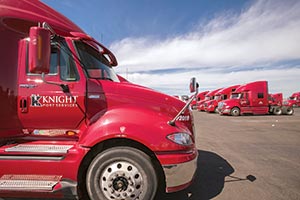Big Drop in Class 8 Registrations Signals End of Truck-Buying Spree

This story appears in the Nov. 28 print edition of Transport Topics.
A sharp decline in registrations of new trucks is taking the air out of what has been a remarkably robust period of growth in the size of the nation’s Class 8 fleet.
Registrations of new heavy- duty tractors and straight trucks fell 26.6% to 49,742 vehicles in the third quarter from 67,805 during the same quarter of 2015. They also are down 18.3% to 162,110, year to date, compared with 198,519 in the same nine-month period in 2015, IHS Automotive reported in its quarterly commercial vehicle report released Nov. 18.
The drop in new registrations signals an end to a prolonged buying spree that added 490,000 vehicles to the U.S. Class 8 truck fleet over the past three years.
“The decline in Class 8 new registrations can be directly attributed to the decline in new registrations by fleets operating 500 or more vehicles,” said Gary Meteer, director of commercial solutions at IHS. “We started to see this pattern develop during the last half of 2015, and it has continued through the first nine months of 2016.”
The total number of all Class 8 trucks in operation in the United States topped 4 million for the first time in the second quarter of 2016 and reached 4.03 million in the latest quarter, accord- ing to data compiled by IHS from the 50 state motor vehicle departments.
Heavy-duty vehicles have been the dominant segment for new truck registrations since 2011, but now the market appears to be shifting toward smaller classes of vehicles used in vocational and service fleets, Meteer said.
Registrations of new Class 4 trucks are up 22% through the first nine months of this year compared with the same period in 2015, and registrations for Classes 5-6 vehicles also are up by 11% and 13.2%, respectively, IHS reported.
The freight market right now is “not great,” said Craig Kendall, specialty markets manager for the Pete Store, a Knoxville, Tennessee- based truck dealer with 14 locations in seven states. “I would describe it as so-so.”
Most trucking fleets are buying for replacement, not expansion, Kendall said, adding that he does see improving demand for trucks from buyers of vocational vehicles.
“Oil and gas drilling activity is coming back, and there is a little more export activity,” he said.
Executives at Knight Transportation Inc., a Phoenix-based truckload carrier, say they are keeping trucks in service longer in response to market conditions.
“We’ve extended the expected trade cycle of our tractors,” Chief Financial Officer Adam Miller said in a conference call with investment analysts after reporting results for the third quarter.
Knight ranks No. 29 on the Transport Topics Top 100 list of the largest U.S. and Canadian for-hire carriers.
Miller said the average age of tractors in Knight’s fleet has increased to 2 years old from 1.8 years, and the company has taken steps to bolster its preventative maintenance program to offset additional costs associated with a slightly older tractor fleet.
CEO David Jackson said falling prices for used equipment are making it more difficult for companies to finance the purchase of new trucks, and that is likely to lead to reductions in freight-hauling capacity.
“The equipment valuation declines we’ve seen would be a major headwind to the ability of small carriers, in particular, to seek leverage,” Jackson told analysts Oct. 26.
Asked when conditions would favor expanding the fleet, Jackson said the company must first assess the strength of demand and pricing during November and December, when many shippers lock in bids for the following year. Knight then must make adjustments in driver pay to ensure it can get enough drivers before it orders more trucks.
“We’re probably looking into the second quarter ... to be in a spot to add capacity and for it to work out,” Jackson said.
Industry analyst John Blodgett of MacKay & Co. in Lombard, Illinois, said he expects sales of Class 8s to continue trending lower in 2017 despite a positive economic outlook.
Blodgett projects retail sales of about 180,000 heavy-duty U.S. trucks in 2017 compared with about 200,000 trucks in 2016.
One reason for the sales decline, he noted, is a glut of late-model used trucks, which keeps a lid on the value of trade-ins and forces buyers to come up with more cash to buy new vehicles.
Also at issue is fleet utilization, which Blodgett said was lower than anticipated in the third quarter and may make some fleets reluctant to invest in more equipment.
Much also will depend on how long it takes for the new Trump administration to implement changes in economic and regulatory policies.
“If they are quick about plans, whether you like it or not,” Blodgett said, “you can begin to make decisions.”

